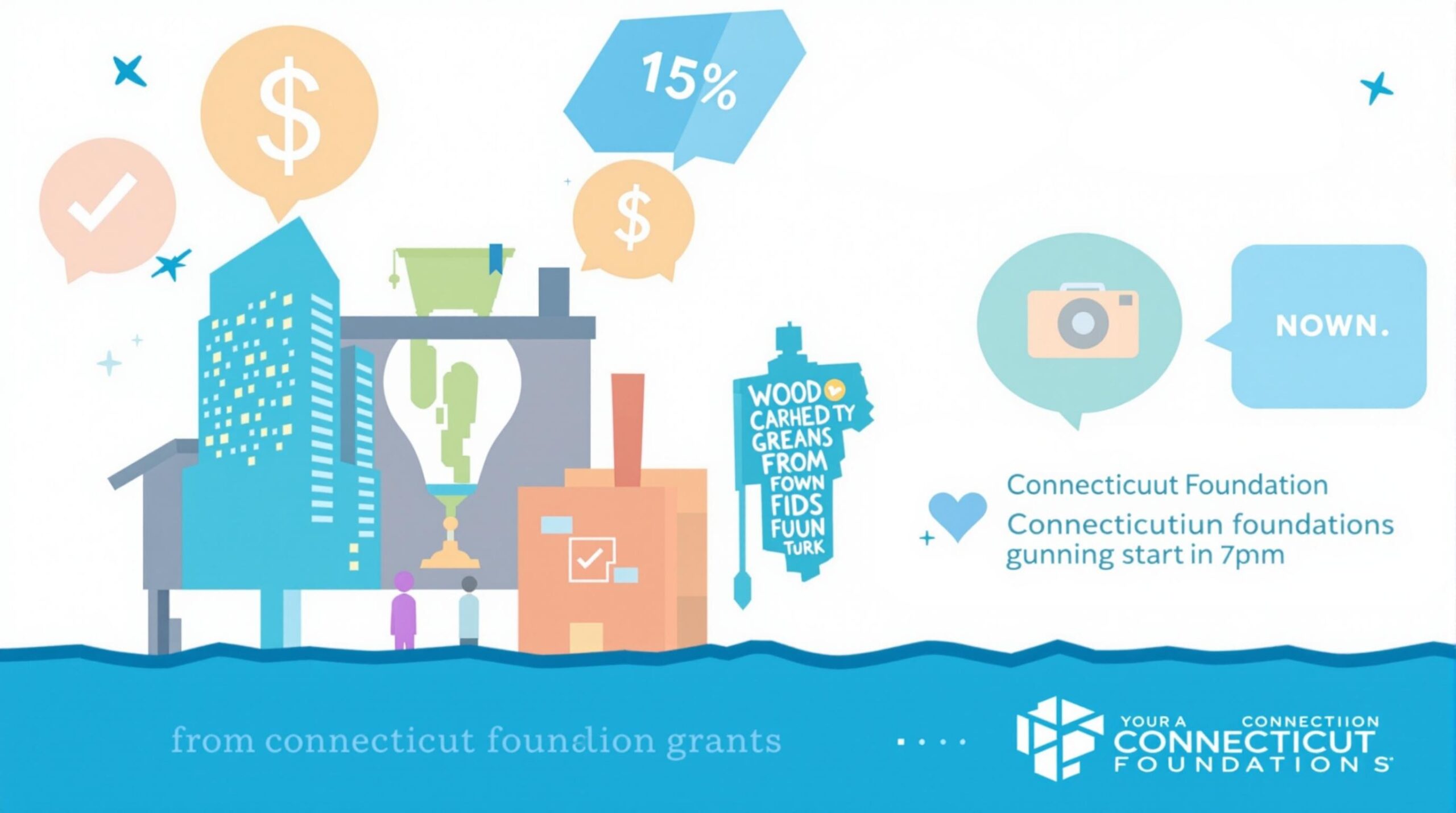Connecticut is setting the standard for educational support through a network of dedicated charitable organizations that fund everything from K-12 programs to workforce development initiatives. The state’s top ten Connecticut foundations are bridging critical funding gaps between public education budgets and the actual costs of quality learning experiences, creating pathways for students and professionals to advance their education and careers without excessive financial burden.
Key Takeaways
- Connecticut foundations distribute over $15 million annually in educational grants and scholarships, helping reduce the average $35,000 student debt burden
- Foundation-funded career development programs show 95% college acceptance rates among participants, significantly exceeding district averages
- Recipients of foundation-supported healthcare training programs earn 25% higher starting wages than state averages for entry-level positions
- Educational foundations are increasingly focusing on equity-centered funding models that include transportation and childcare support alongside tuition assistance
- Applications for most foundation grants have deadlines between January and April for the following academic year’s funding
Connecticut’s Educational Landscape and Funding Needs
Connecticut boasts impressive educational statistics with 88.6% of residents holding high school diplomas and 35.6% possessing post-secondary degrees. Despite these achievements, the state faces significant financial challenges in education. The average annual college cost in Connecticut reaches $15,000, leading to an average student debt of $35,000 for graduates.
While Connecticut maintains a substantial $9.5 billion state education budget, this funding can’t address all educational needs. The gap becomes particularly evident in high-growth employment sectors like healthcare, which projects 15% growth by 2030, and information technology, with 12% expected growth. These expanding industries require specialized educational support that often falls outside traditional funding models.
Foundation support has become essential for filling these gaps, particularly for underrepresented populations and first-generation students. By providing targeted educational grants that align with economic development priorities, Connecticut foundations are creating sustainable pathways to education and career advancement.

Connecticut Foundations Supporting K-12 Education and Teacher Development
The Connecticut Education Foundation (CEF) stands at the forefront of K-12 support through its five specialized funds benefiting both educators and students. The DiGiovanni Future Teacher Scholarship provides up to $5,000 for children of Connecticut Education Association members pursuing teaching careers, addressing intergenerational educational advancement.
CEF also demonstrates its commitment to diversity through the Racially & Ethnically Diverse Educator Scholarship, which specifically targets minority students entering the teaching profession. This initiative helps address representation gaps in Connecticut’s teaching workforce.
Another significant contributor is the American Savings Foundation, which awards community grants up to $5,000 across 64 towns. Their recent contributions include $105,500 for youth programs and $150,000 for academic support initiatives in New Britain alone. Unlike some foundations, they prioritize programmatic support over event sponsorship, ensuring sustainable educational impact.
The landscape of K-12 support extends to private education through Foundations in Education, which supports 32 Catholic schools in Fairfield County. Their annual contribution of $4.7 million in tuition assistance has proven effective, with 85% of scholarship recipients eventually graduating from college – a remarkable achievement highlighting the long-term impact of early educational investment.
Higher Education Access Through Statewide Foundations
For students pursuing higher education, the ECSU Foundation manages endowments providing over $1 million in scholarships annually. These funds directly reduce student debt burden, a critical concern given that Connecticut students average $35,000 in educational debt.
Community college students benefit from the Tunxis Foundation, which provides scholarships for CT State Tunxis students. This support is crucial considering 50% of these students require financial aid. The foundation offers named scholarships covering approximately 15% of annual student expenses at $121 per credit – significantly below the state average of $185 per credit.
The CT State Tuition-Free Program represents an innovative approach to college affordability. This program covers tuition gaps for up to 72 credits with no residency restrictions. The impact is particularly notable among underrepresented populations, with 45% of recipients being first-generation college students and 60% enrolling in high-demand programs like healthcare and IT.
These foundations providing educational grants are transforming higher education access across Connecticut, creating pathways for students who might otherwise be unable to pursue degrees due to financial constraints.
Career Pathway Programs and Workforce Development Initiatives
The Hartford Foundation for Public Giving has made significant investments in career development, including funding ReadyCT’s $530,000 initiative for Black and Latine students in healthcare and IT sectors. This targeted approach addresses both educational equity and workforce needs in high-growth industries.
Their Career Beginnings program demonstrates remarkable success with a 73% college enrollment rate and a 95% acceptance rate – exceeding district averages by 10%. These statistics highlight the effectiveness of structured career pathway programs in improving educational outcomes.
The Community Foundation for Greater New Haven has also made substantial contributions, awarding $684,000 in 2022 to 15 career pathway programs. One beneficiary, ConnCAT, exemplifies the economic impact of such funding, with participants earning an average starting wage of $22 per hour in healthcare roles after completing training.
CHEFA’s CT SHIP Project represents a large-scale approach to workforce development through its $6.9 million initiative combining federal ($3.4 million) and state ($3.5 million) funding. This collaborative effort between CT State Norwalk, Gateway, and Middlesex colleges aims to train 1,200 students in healthcare fields, addressing critical workforce shortages.
Industry-Education Partnerships Bridging the Skills Gap
CBIA’s Education Foundation exemplifies the power of industry-education collaboration through partnerships that expand AP courses and manufacturing training. These programs have impacted 3,248 students across 19 schools, with 85% of AP students pursuing STEM degrees – directly addressing Connecticut’s need for qualified technical workers.
The foundation’s manufacturing expos have reached 6,000 students, providing direct exposure to career opportunities in advanced manufacturing. This hands-on approach helps address the statewide skills gap in this critical sector.
ConnCAT’s healthcare and bioscience training program demonstrates another successful model, providing a direct pipeline to industry jobs. By aligning curriculum with employer needs, these programs ensure graduates possess immediately applicable skills.
A particularly promising development is the cross-sector collaboration between CT State Norwalk, Gateway, and Middlesex colleges. This partnership projects over 300 annual healthcare job placements by 2025, addressing critical workforce shortages while providing economic opportunities for program participants.
Learning to navigate grants for educational funding has become an essential skill for both educators and students seeking to benefit from these industry partnerships.
Equity-Focused Scholarship and Grant Opportunities
The Connecticut Education Foundation addresses financial barriers for educators earning an average salary of $63,152 – a figure that can be insufficient given Connecticut’s high cost of living. Their support enables professional development opportunities that might otherwise be inaccessible.
The Community Foundation for Greater New Haven emphasizes the importance of comprehensive support through transportation and childcare subsidies. This approach recognizes that tuition assistance alone may be insufficient for low-income program participants with family responsibilities.
The Racially & Ethnically Diverse Educator Scholarship specifically targets increasing workforce diversity in education. This targeted approach addresses representation gaps that persist in Connecticut’s teaching profession.
Catholic school tuition assistance in the $6,000-$12,000 range makes private education more accessible to families across various income levels. This creates educational options that might otherwise be financially out of reach.
Across these programs, there’s a clear prioritization of underrepresented populations in high-demand sectors. This dual focus on equity and workforce development creates pathways to economic mobility while addressing critical skills gaps.
Innovative Grant Models and Application Strategies
The American Savings Foundation demonstrates innovation through its focus on programmatic support rather than event sponsorships. This approach ensures sustainable educational impact rather than one-time activities with limited long-term value.
The Hartford Foundation supports wraparound services alongside direct educational funding, recognizing that academic success often depends on addressing non-educational barriers like housing stability, transportation, and healthcare access.
CBIA offers teacher externships that connect classroom instruction to industry needs. This model creates authentic learning experiences that prepare students for actual workplace expectations.
For those seeking foundation support, understanding application requirements is essential. Most foundations require FAFSA completion for education-related funding, along with program-specific criteria. Application deadlines typically fall between January and April for the following academic year’s funding.
Multi-year funding models are increasingly common, providing sustainable support for long-term educational initiatives. This approach allows for deeper impact measurement and program refinement over time.
Measuring Impact: Success Stories and Outcomes
ConnCAT participants earn 25% higher wages than the state average for entry-level healthcare positions, demonstrating the economic value of foundation-funded training. This wage premium translates to greater financial stability and reduced need for public assistance.
The Career Beginnings program’s 95% college acceptance rate showcases how structured support can dramatically improve educational outcomes. This success rate far exceeds typical district averages, highlighting the program’s effectiveness.
Catholic school scholarship recipients demonstrate impressive long-term educational attainment, with 85% graduating from college. This statistic suggests that early educational investment yields significant later-life benefits.
CBIA programs have successfully influenced academic pathways, with 85% of AP students pursuing STEM degrees. This outcome directly addresses Connecticut’s workforce needs in technical fields while providing students with access to high-wage career opportunities.
Collectively, foundation-funded programs are addressing Connecticut’s workforce needs while promoting educational equity. The combination of immediate economic impact and long-term educational attainment creates a compelling case for continued investment in these initiatives.
Future Outlook and Application Resources
Connecticut foundations are increasingly emphasizing cross-sector collaboration and public-private partnerships. This trend reflects recognition that complex educational challenges require coordinated responses from multiple stakeholders.
For prospective applicants, understanding application timelines is crucial. While deadlines typically fall between January and April for academic year funding, planning should begin months earlier to ensure complete and competitive applications.
There’s a growing focus on certificates and credentials aligned with Connecticut’s economic development priorities. This emphasis on shorter-term, targeted credentials reflects both workforce needs and student preferences for more affordable educational options.
Expanding wraparound services will be critical for program sustainability. As foundations recognize the multiple barriers facing many students, comprehensive support models are becoming standard practice rather than exceptions.
Resources for applicants include foundation websites, the Connecticut Council for Philanthropy



